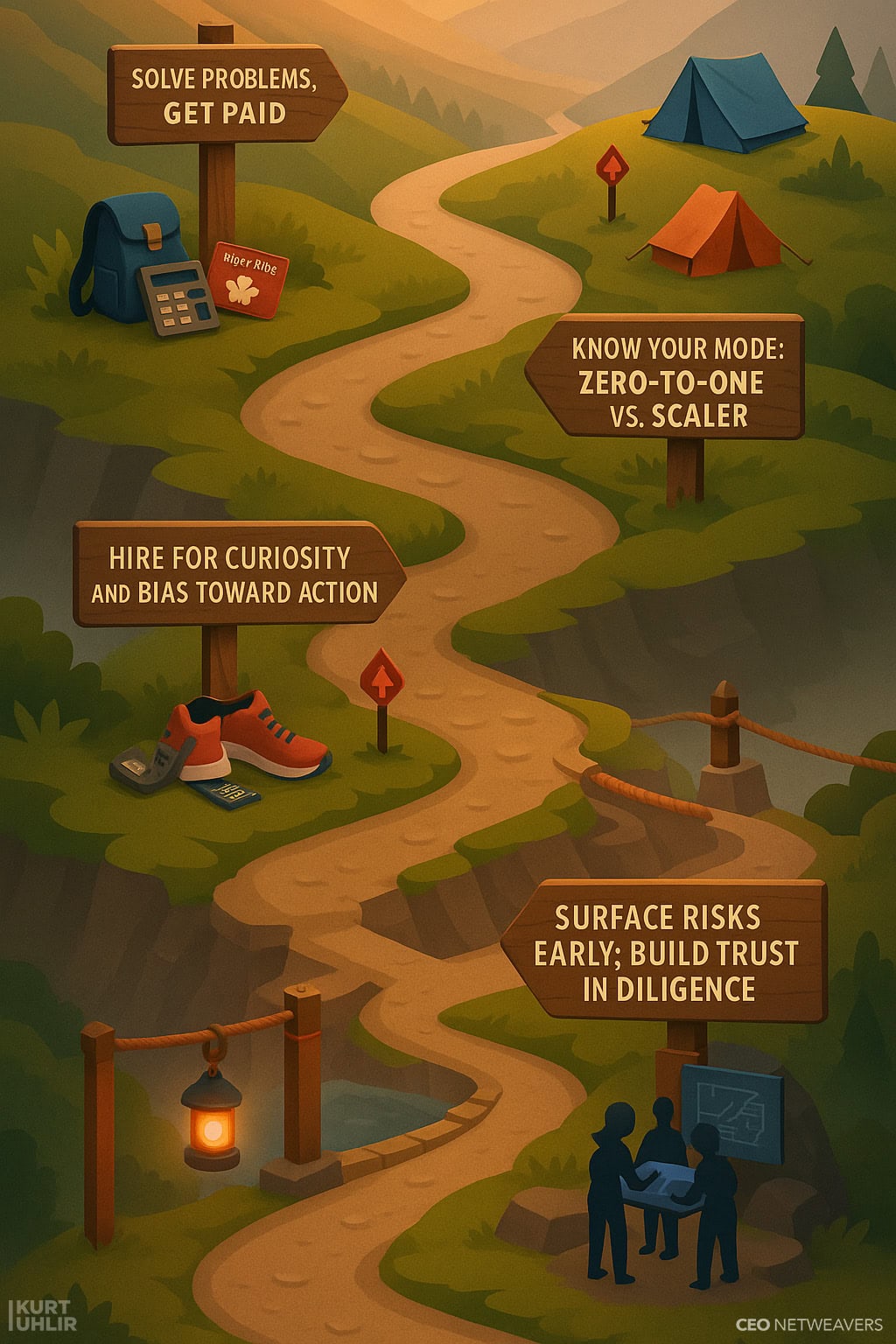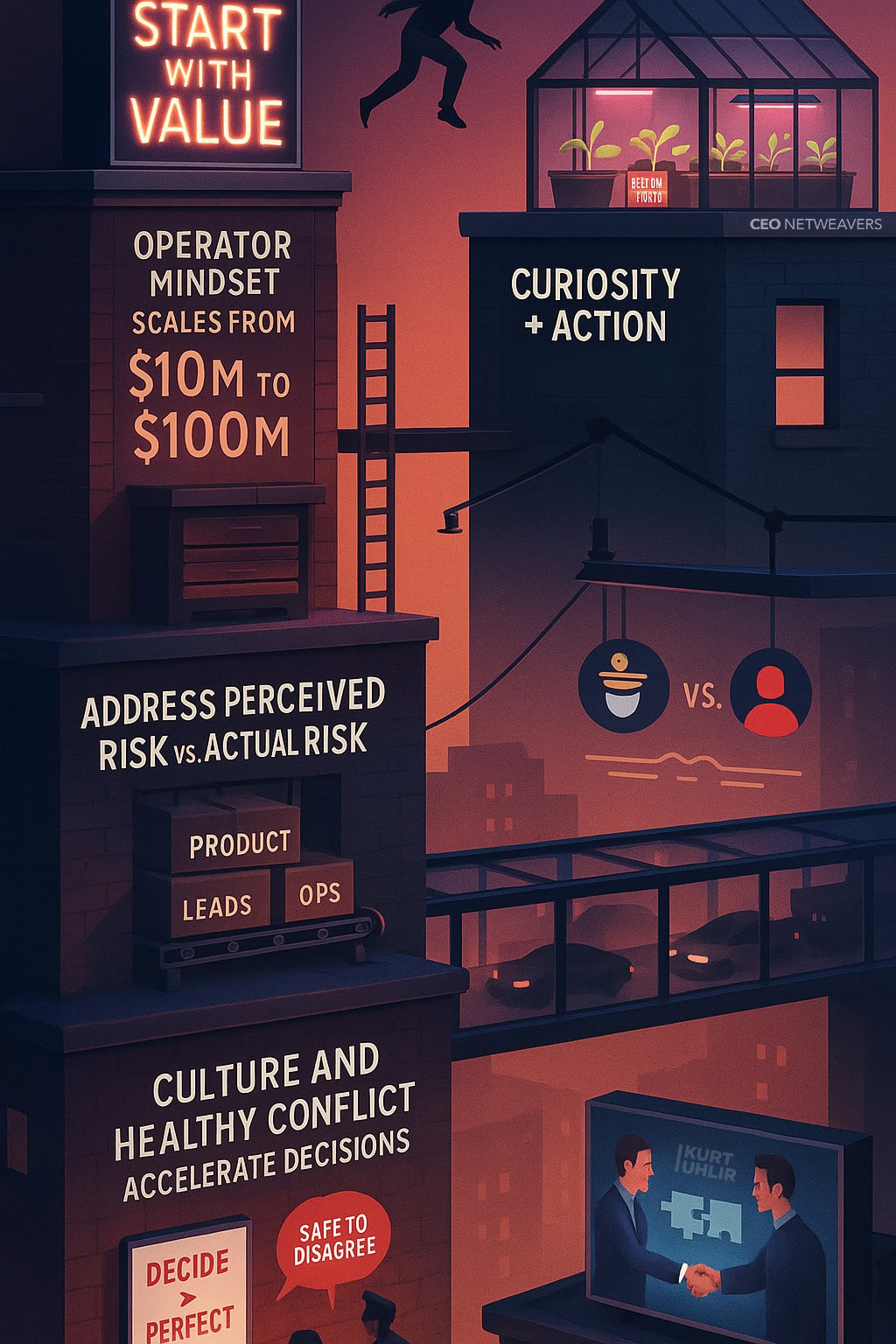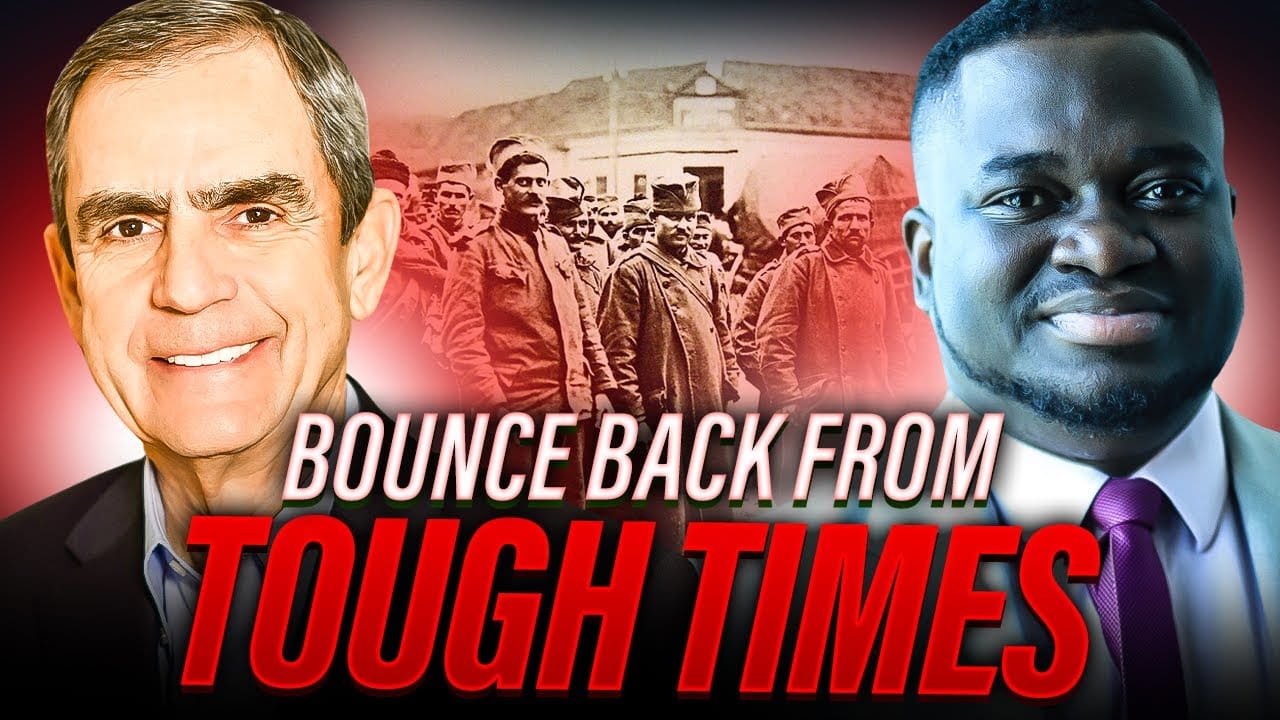You can accelerate growth without blowing up your team, your time, or your exit. That’s the core message CEO Netweaver member Kurt Uhlir’s recent conversation with Simon Bedard on the Buy Grow Sell podcast—a fast-moving masterclass on when to build, when to buy, and how to scale from $10M to $100M without losing the plot.
Kurt isn’t a “talking head.” He’s a full-time CMO, CEO Netweaver member, and growth operator who’s scaled category leaders across B2B SaaS, data platforms, and real estate tech. He’s helped drive acquisitions at NAVTEQ (now HERE), invented and led go-to-market for software used by Meta, Apple, and Microsoft, sold a social SaaS company to Oracle (Vitrue), led growth marketing at eXp Realty and eXp World Holdings properties like Showcase IDX. Today, you’ll find him with mid-market companies or those incredibly high-potential companies that are preparing to scale. That perspective shows up in every answer—technical when it matters, operator‑practical always.
Below is what CEOs, PE partners, and go-to-market leaders should take away from the episode—and how today’s deal data backs it up.
Note: All quoted lines from the recording are formatted in italics.
The Operator’s Edge: Know If You’re Zero‑to‑One or One‑to‑One‑Hundred
Kurt’s biggest self-awareness unlock came from a mentor:
- “You’re a scaler. The zero-to-one stuff is painful for you. Give you $10M or $100M and you 100x it.”
That distinction matters at $10M to $50M revenue, where many companies stall.
Zero‑to‑one founders chase novelty; scalers systematize demand, simplify operating models, and compound unit economics. If you’re wired like Kurt, your superpower is making what already works, work harder—without breaking culture.
The show also touched on enduring leadership disciplines: hiring for curiosity and a “bias toward action,” and building a team comfortable with “healthy conflict” before the heat of the moment. Those are the muscles that hold under pressure in scale-up mode.

Buy vs. Build: Reverse‑Engineer Strategic Fit
Kurt’s track record spans both sides: starting and selling businesses, and leading corporate acquisitions. His blunt counsel:
- If your wiring tilts to scale, don’t romanticize greenfield building. Acquisitions can install the capability you need next quarter—not next year.
- Be honest about whether you’re building a product, a feature, or a business. “Too many early tech companies are really features. Somebody will squash you.”
That’s not theory. At NAVTEQ, the team acquired Traffic.com to fill a real-time data gap and API platform already on the product roadmap—then integrated the leadership and platform to run “all software and APIs” inside the broader business two years later. The deal was announced in November 2006 and closed in March 2007 for approximately $177–$187 million. (sec.gov)
Likewise, at Vitrue, one of the first social media management SaaS platforms (sold to Oracle in 2012 for roughly $300 million), the team engaged strategic buyers early because those companies were already having the “build vs. buy” discussion. That kind of reverse-engineered pipeline—starting from an acquirer’s gaps—amplifies optionality, valuation, and speed. (en.wikipedia.org)
What the Market Data Says Right Now
- Programmatic acquirers that do many small and midsize deals consistently outperform on long‑term TSR versus “big bet” or purely organic strategies. Multiple McKinsey studies over the past decade reaffirm that advantage—about 2–2.3% excess annual TSR compounded over ten years. (mckinsey.com)
- 2024–2025 deal flow skewed large on value but lighter on volume, with megadeals rebounding while mid‑market sellers and buyers still wrestle with valuation gaps and financing costs. Average deal sizes rose, even as total volumes sagged; corporates and top PE funds led the >$1B cohort. (pwc.com)
- Add‑ons are the PE workhorse. Roughly three‑quarters of buyouts in 2023–2025 included add‑on acquisitions, underscoring buy‑and‑build’s resilience when credit tightens and when platform arbitrage is attractive. (goodwinlaw.com)
- Earn‑outs are still the go‑to bridge for valuation gaps. Usage remains elevated versus pre‑pandemic norms, with PE‑ and VC‑backed deals accounting for a rising share. Translation: expect more deferred consideration, tighter covenants, and a heavier focus on integration KPIs. (spglobal.com)
If you’re considering your own buy‑vs‑build calculus, from either side of the decision table, the macro tailwinds are clear: there’s capital for well‑structured add‑ons, strategic buyers continue to fill capability gaps, and earn‑outs can still close pricing distance—as long as you set the operating rules upfront.
Kurt and Simon talk through how there is a huge opportunity for companies that are doing small acquisitions in the $500k to $2M range, if approached properly.
The Often‑Ignored Truth About Earn‑Outs
Founders and early investors often make decisions based on their belief that they’ll receive the full deal numbers, but how often does that actually happen?
Kurt’s take was refreshingly candid:
“I’d be surprised if a third of earn‑outs hit 90–100%.”
That aligns with what many of our senior members have seen. Earn‑outs are powerful but fragile. They fall apart when:
- The founder mentally “exits” after close.
- Operational levers the seller assumed they’d keep vanish in big‑company processes.
- There’s ambiguity on GAAP policies, cost allocations, or channel conflict.
Market data reinforces the trend: earn‑outs were present in about 37% of 2023 deals (ex‑life sciences and de‑SPACs) versus ~20% in 2018–2019. Increased usage hasn’t created a litigation spike, but disputes still concentrate around how the business must be operated during the earn‑out window. The fix is structure and clarity. (corpgov.law.harvard.edu)
Tactically, if you’re selling:
- Nail down the operating “sandbox”: pricing authority, channel access, hiring plans, and who can approve changes to the go‑to‑market motion.
- Define accounting policies inside the earn‑out math (revenue recognition, cost allocations, intercompany charges).
- Tie earn‑out metrics to levers you control: contribution margin dollars, paid seat growth, ARR net adds—not squishy “synergies.”
If you’re buying, remember Kurt’s cultural lens: you’re acquiring a leadership team and muscle memory. Protect the conditions that produced their results, especially in the first 6–12 months.
Due Diligence and Transparency: Say the Quiet Part Early
Kurt was unequivocal: if you’re selling and there’s a skeleton in the closet, bring it to the table before you’re “pot committed.”
- “When it’s later, it feels weightier.”
- “These will be your co‑workers. Do you want to start with trust issues?”
The research backs him up. Cultural friction is consistently cited as a top cause of failed integrations, and it’s preventable if you surface the differences early and design for them. McKinsey reports that 44–95% of executives identify culture as critical to integration success; when leaders manage culture intentionally, deals are up to 70% more likely to meet revenue targets and 40%+ more likely to meet cost synergies. (mckinsey.com)
Sellers: If you have customer concentration, IP assignment ambiguities, or a pending key‑hire risk—surface it and price it. Buyers will load those into modeling anyway; you’ll get more credit with transparency than with optimism.

Build for the Life You Want—Then Back Into the Deal Strategy
One of the strongest moments in the interview came when Simon reframed business around resource allocation and lifestyle:
- “You’re not born to do business—you’re born to live your life. Structure the business to deliver the life you want.”
Kurt agreed. He and his family actively plan where to steward time, not just money. The lesson for operators and founders isn’t soft; it’s strategic. Lifestyle constraints clarify operating design: remote vs. hybrid, market focus, how much integration complexity you’re willing to absorb, and the earn‑out you can tolerate.
That matters especially now.
Since 2020, many high‑caliber executives have chosen autonomy over headquarters jobs; PE is doing more down‑market add‑ons; and “entrepreneurship through acquisition” has exploded among younger leaders who prefer managing and improving to starting from scratch. In 2023, first‑time search funds hit record numbers, with the majority of new fund managers under 35. We’re also seeing more companies practice labor hoarding to make sure they have the talent bench available to move quickly. (businessinsider.com)
The upshot: You can design a buy‑and‑build engine that throws off real cash, elevates a 20‑person team, and never requires you to sit in traffic again. Don’t measure success solely by logo size or headcount.
Cross‑Border Deals: Value Is Earned in Integration, Not Headlines
Simon asked about cross‑border acquisitions and the realities beyond time zones.
Kurt has executed in Europe and Asia, from Germany to Korea and China, and made a point most miss: geography determines corporate mechanics. Each new country can be “like setting up a new company” in legal, tax, and HR terms.
The published research is clear: cross‑border deals add a layer of culture on top of corporate culture—national norms, management styles, and decision rights—and you have to diagnose those differences early. Integration programs that formally address culture and leadership alignment post‑close outperform on talent retention, synergy capture, and TSR. (mckinsey.com)
A practical filter many in CEO Netweavers use: if the prospective buyer isn’t already operating in your country (or at least in your region with shared back office), your deal will either (a) be priced to fund that infrastructure or (b) stall in integration. Plan accordingly.

Case Study Threads From the Interview
- Early business building: Kurt started as a teenager, formed LLCs at 14, and sold his first services business before college. It wasn’t the “romance of startups”; it was learning to bolt on adjacent services (e.g., lawn care → pressure washing) and hire friends at better wages than retail—an early lesson in margin stacking and resource allocation.
- NAVTEQ and Traffic.com: The real-time traffic ingestion gap was known; acquire to fill, then hand the platform to the best operators. That acquired team ultimately ran software and APIs company‑wide after the acquisition closed in March 2007. A classic “buy the capability and the people, not just the code” story. (sec.gov)
- Vitrue to Oracle: As the social stack matured, Vitrue met large‑platform buyers (Adobe, Salesforce, Oracle) where they were already working closely and began discussing a strategic investment. When one of those said they’d rather have a “buy” discussion, Reggie and Kurt changed the discussions with everyone. Schedule the conversation before they issue the RFP. Oracle announced the acquisition of Vitrue on May 23, 2012. (en.wikipedia.org)
- eXp Realty and Showcase IDX: Kurt’s later work sat inside one of the few truly global, cloud‑native brokerages. eXp World Holdings acquired Showcase IDX, a martech SaaS platform, in 2020 to deepen consumer search and agent lead conversion, and eXp has continued international expansion—announcing Türkiye, Peru, and Egypt for 2025, bringing operations to 27 countries once launched. That’s a live example of “buy for capability, then scale programmatically.” (globenewswire.com)
How to 10x From $10M: The Playbook Most Companies Skip
Here’s the execution checklist I recommend to founders, CEOs, and PE ops partners—bridging Kurt’s operator instincts with today’s market realities.
1) Decide: Build the Engine or Buy the Engine
- Map your next two years of growth constraints: distribution, attach rate, product coverage, proof at the top of the funnel, sales cycle time.
- If 60%+ of your plan hinges on capabilities you don’t have—and can’t stand up in 2–3 quarters with confidence—shop for them. Use programmatic M&A logic: smaller, bolt‑on deals that fit tightly, not vanity megadeals. The returns data favors this approach. (mckinsey.com)
2) Reverse‑Engineer the Buyer/Seller Landscape
- As Kurt noted with Vitrue and NAVTEQ, deals flow from relationships and transparency. Publish your “gaps we intend to fill” to your banker, investor network, and operating peers. You’ll see inbound targets that fit your roadmap instead of random inbound opportunities. On the sell side, start the conversation with strategics who are already debating build vs. buy.
3) Get Candid on Culture Early
- Run a “ways of working” diagnostic with the target before LOI. Decision rights, cadence, CRM hygiene, marketing ops maturity, pricing norms. If the delta is wide, make culture integration a day‑one KPI, not a poster.
- Assign a single executive sponsor for cultural integration and measure it like a revenue synergy. Companies that do this outperform on both cost and revenue synergies. (upgrade.mckinsey.com.br)
4) Structure Earn‑Outs You Can Actually Earn
- Treat the earn‑out as a mini‑budget with control rights. Define the sandbox and accounting policies in the agreement. The current market uses earn‑outs heavily to bridge valuation gaps—smart structure is the difference between payout and heartburn. (spglobal.com)
5) Price in the Integration
- Cross‑border? Budget as if you’re standing up a net‑new company. It’s often true in practice. Build a sequencing plan for payroll, benefits, tax, and data governance. Don’t let legal entity delay stall revenue capture. (mckinsey.com)
6) Keep the Scalers in Their Lane
- Not everyone should run zero‑to‑one. Kurt’s self‑assessment—“I scale; I don’t hunt for PMF starting from scratch”—is a model for role clarity. If your founder is a visionary “mad scientist,” put an integrator/COO on the field with real authority. If your CMO is a scaler (Kurt’s profile), don’t burn six months trying to make them invent an unproven category. Aim their energy where unit economics already work.
For Recruiters and Boards: The Profiles That Win Here
- CMO/CRO who can play “systems builder,” not just storyteller. Kurt’s edge in Enterprise SEO and demand generation systems came from engineering‑level thinking. If you hear “we’ll just run a big brand campaign,” keep interviewing.
- CFO with M&A muscle and controllership discipline. You want people in your c-suite that “know” what scaling feels like. Earn‑out math, segment reporting, and allocation policy need to be clean to avoid disputes and ensure the operating team knows how to “earn.”
- Head of Integration with authority. Not a PM—an executive leader with decision rights across product, GTM, finance, and HR.
And don’t underestimate the value of an advisory board on equity. As Kurt put it, give three to five proven operators real skin in the game 12–36 months before you plan to sell. That seasoning pays off—both in execution and in credibility when buyers diligence your team.
Servant Leadership at Scale
Kurt closed the episode with a leadership lens that resonates across CEO Netweavers:
“My definition of success is multiplying good, healthy, servant leadership in others.”
I’ve worked with Kurt in Atlanta, and that posture is real. It shows up in how he hires for curiosity, invites “pre‑fighting” on tough topics, and insists that time stewardship matters as much as capital allocation. High‑achieving servant leadership is not softness. It’s the operating system for sustained, compounding growth.
A Note on eXp Realty’s Model and Why It Matters
As context for listeners new to Kurt’s full-time roles: eXp Realty is one of the only truly cloud‑native brokerages operating at global scale. The company has expanded across the U.S., Canada, and more than 20 international markets, and announced plans to launch Türkiye, Peru, and Egypt in 2025—bringing its footprint to 27 countries once live. The Showcase IDX acquisition in 2020 demonstrates the same “buy capabilities to accelerate the roadmap” logic that Kurt champions in the interview. (sec.gov). Kurt and the team then took the martech capabilities they needed for the holding company and divested the SaaS subsidiary to another public company.
For CEOs outside real estate: study this play. Cloud‑first ops, programmatic expansion, bolt‑on capabilities to improve agent productivity (your equivalent: seller or partner productivity), and a leadership model that scales beyond headquarters.
Quick Hits: What I’d Tell a CEO After This Episode
- If your growth thesis depends on adding one new motion (e.g., a product module, a channel, or a data feed), default to buy. Do it programmatically, not gigantically. The data favors it, the integration risk is manageable, and you can show results inside two quarters. (mckinsey.com)
- If you must build, fund it like a product business with an internal P&L, milestone gates, and clear kill criteria. Don’t let pet projects steal oxygen from proven engines.
- If you’re selling within 24 months, create your advisory board now. Give equity. Get scar tissue in the room. Your diligence experience—and valuation—will be better for it.
- Make culture a tracked synergy. Owner: named. KPIs: defined. Cadence: weekly for Q1, biweekly for Q2. (mckinsey.com)
- Write the earn‑out you can live with on your worst week. If it requires heroics in a new parent company with different CRM, pricing, or channel rules, you won’t hit it. (corpgov.law.harvard.edu)
Why You Should Care
Owners and operators who want to scale value and exit on their terms. This episode delivered a rare blend: honest war stories, practical operating guidance, and deal‑maker realism—without sugarcoating the hard parts. Simon kept the conversation grounded in what actually drives valuation and close probability, not just theory. If you’re a mid‑market CEO, a PE ops partner, or an executive recruiter placing scale‑stage leaders, this is the texture you need.
Final Takeaway and Next Step
You don’t need a megadeal to create a remarkable outcome. You need a clear life design, the humility to play your natural position (builder vs. scaler), and the discipline to run a programmatic playbook: buy where it accelerates, integrate culture like it’s a P&L line, and structure earn‑outs you can actually earn.
Action for this week:
- Identify one capability you could acquire in the next two quarters that would accelerate your 2026 plan by 12 months or more. Build a one‑page reverse‑brief: “What a perfect target looks like,” including control rights you’d need post‑close. Share it with your banker, your board chair, and two operators you trust.
If you’d like a second set of eyes on that one‑pager—or want the full notes from Kurt Uhlir’s conversation—reach out through CEO Netweavers. And if you haven’t yet, listen to Simon’s Buy Grow Sell episode with Kurt; it’s worth your next commute.
References (selected):
- NAVTEQ’s acquisition of Traffic.com closed March 6, 2007; total consideration ~ $177–$187 million. (sec.gov)
- Oracle announced its acquisition of Vitrue on May 23, 2012 (approx. $300 million). (en.wikipedia.org)
- eXp World Holdings acquired Showcase IDX in August 2020; eXp has announced expansion to 27 countries once Türkiye, Peru, and Egypt launch in 2025; see 2024 10‑K. (globenewswire.com)
- Programmatic M&A outperforms on long‑term TSR; repeated McKinsey findings. (mckinsey.com)
- 2024–2025 deal trends: megadeals rebounded; mid‑market volumes lagged; add‑ons remain ~74–76% of PE buyouts. (pwc.com)
- Earn‑out usage elevated post‑2020; common dispute themes; structure matters. (spglobal.com)
- Culture is a top driver of M&A success and failure; manage it from day zero. (mckinsey.com)
Listen to the full Buy Grow Sell conversation with Simon Bedard and Kurt Uhlir, and then draft your one‑pager. The next compounding decision is yours.











